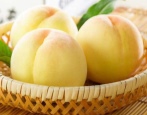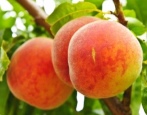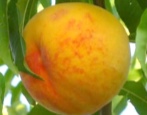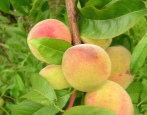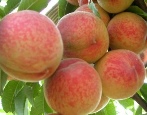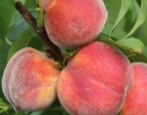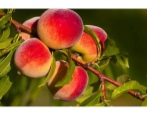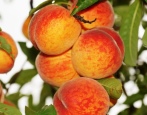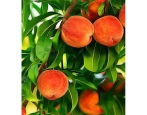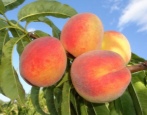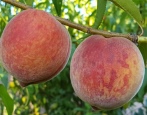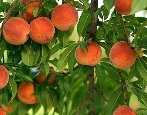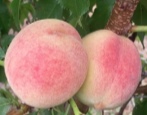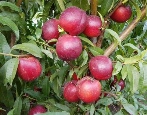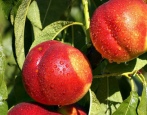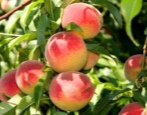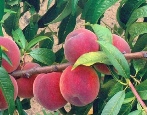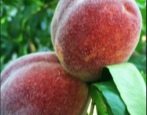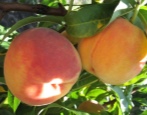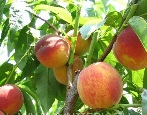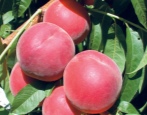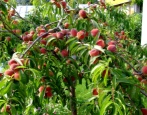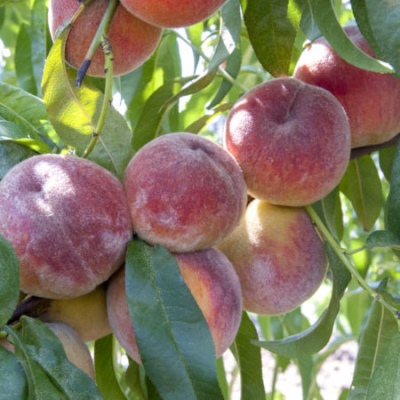
- Authors: THEM. Ryadnova, G.V. Eremin, T.S. Vasilenko (Crimean experimental breeding station VNIIR)
- Appeared when crossing: Golden Jubilee x Rochester + Rot Front + Arp Beauty
- Year of approval: 1987
- Ripening period: early
- Appointment: for fresh consumption, for canning
- Yield: high
- Growing regions: North Caucasian
- Separability of the bone from the pulp: not separable
- Fruit composition: sugars - 9.8%, acids - 0.69%, dry matter - 12.5%
- Winter hardiness: above average
Many fruit lovers want to grow a peach tree with excellent fruits in their garden. The taste and presentation of the peach variety Pamyat Simirenko meet the requirements of gardeners. Therefore, they are often grown in summer cottages and on farms.
Breeding history
The hybrid peach was bred by three talented breeders I. M. Ryadnova, G. V. Eremin, T. S. Vasilenko. Employees of the Crimean Experimental Breeding Station received a new interesting variety thanks to the crossing of the fragrant variety Golden Jubilee x Rochester with Rot Front and Arp Beauty. The novelty was included in the state register in 1987, recommending it for cultivation in the North Caucasus region (Krasnodar Territory and the Republic of Adygea).
Description of the variety
The tree does not grow higher than 3 m. It has a rounded, not too dense crown, which is decorated with large pink flowers in April. Leaf plates of a characteristic color and shape of a peach.
Fruit characteristics
Peach size Simirenko's memory is considered large. They are orange-yellow in color, with stripes and patches of dark red blush. Rounded fruits reach a weight of 100-130 grams. This is the average weight of a ripe fruit. The fruit is covered with a velvety skin with a light fluff and a wide, but hardly noticeable abdominal seam.
The yellow pulp inside the fruit is tender and fibrous in consistency, moderately juicy. Inside there is a bone with grooves and punctate pits. It does not separate from the pulp. A strong aroma emanates from the peach.
Taste qualities
Peach Pamyat Simirenko has a pleasant and harmonious taste. It contains 9.8%, sugars, 0.69% acids and 12.5% dry matter.
Ripening and fruiting
Peach ripens in July-August, therefore it belongs to the early ripeness varieties.
Yield
The tree of this variety has a high yield. If conditions are favorable, the fruit crop appears already in the first year after planting. But in most cases, the tree begins to bear fruit in the 3rd year. The fruits begin to ripen from the first days of July. Up to 50 kilograms of peaches can be obtained from each tree.
Self-fertility and the need for pollinators
Peach Pamyat Simirenko is characterized by the ability to self-pollination. Planting additional pollinators in the neighborhood is not required.
Growing and caring
Hybrid peach seedlings are purchased in garden centers or specialized nurseries. Fruit crops are planted in sunny areas, well protected from blowing by gusty and piercing winds.
Groundwater should be located at a level of 1.5-2 m from the surface of the earth. For the peach Memory Simirenko, you need a neutral, loose, fertile, low-acid substrate.
The preparation of the site for planting trees is done in advance:
- dig up and loosen the soil, adding minerals and organic fertilizing;
- pits are dug on the site for seedlings, their depth should be 60 cm;
- there should be a distance of 2-2.5 m between plantings, and 3 m in row spacings;
- the seedlings on the day of planting must be kept for 3-4 hours in a container with settled, warm water, and the rhizomes must be treated with a solution of potassium permanganate.
Landing takes place as follows:
- the seedling is immersed in the hole;
- rhizomes are neatly distributed around the perimeter, and fertile soil is poured on top;
- the root collar of a peach tree should rise 2-3 cm above the ground;
- planting work is completed by abundant watering of seedlings and mulching of the soil with organic matter.
Peach variety Pamyat Simirenko needs timely watering and feeding. The number of waterings is selected taking into account weather conditions and climatic indicators in the region where the tree grows.
In the southern regions, during periods of prolonged heat and drought, trees need more frequent watering. In regions with a temperate climate, irrigation is carried out taking into account the amount of natural precipitation.
It is necessary to feed the fruit crop several times per season:
- with the arrival of spring, the soil is enriched with nitrogen-containing fertilizers;
- in the phase of flowering and fruit setting, trees will need potassium and phosphorus as part of the corresponding complexes;
- before wintering, the fruit crop is abundantly watered and fertilized with organic and mineral substances.
The crop needs sanitary pruning in spring and autumn. It is supposed to remove all damaged, dry and broken branches and shoots.
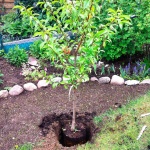
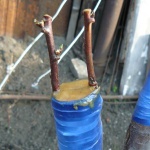
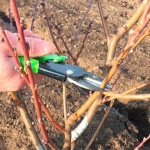
Frost resistance and the need for shelter
Winter hardiness of the fruit tree Simirenko's memory is considered above average. The plant tolerates temperatures as low as -30 degrees. But it needs protection from the cold wind. Peaches growing in southern latitudes do not need shelter during winter rest. But in the climate of the middle zone, it is necessary to cover the plantings with special material, since it is impossible to predict how cold the coming winter will be, and nevertheless, the peach is a thermophilic plant.
Disease and pest resistance
Hybrid peach variety Pamyat Simirenko is resistant to fungi, bacteria, viruses and harmful insects. Stability is assessed by experts at a level above average. But for the purpose of prophylaxis, trees are treated with fungicides and insecticides in spring.
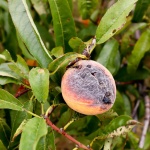
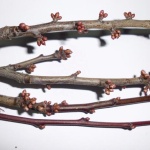
Review overview
The fruits ripen in the second half of July. From the branches, they must be cut off carefully and immediately placed in prepared containers.
Fresh peaches are stored in the refrigerator or placed in special chambers.The fruits have a dense peel, so they easily tolerate transportation without losing their presentation and excellent taste.
But you will not be able to store ripe fruits for a long time, so it is recommended to use them for their intended purpose in the near future. Usually they are eaten fresh or used for canning.
